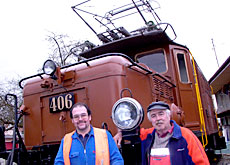
Hobby keeps pensioner on track

Not every woman would put up with a 60-ton crocodile in her garden, but it was a concession Doris Wymann was prepared to make for the sake of her marriage.
Over the past four years, her husband and son have turned their home into a railway zoo, complete with crocodile locomotives and other legendary iron beasts.
Doris Wymann says the old locomotive brings the garden to life, but her husband says she needed some convincing before she agreed to open a museum.
“At the beginning, she wasn’t very thrilled about the idea of setting it up,” remembers Rolf Wymann, smiling.
“But today, she does her bit and when we were given the crocodile locomotive, she said it had to have pride of place in our garden. That’s her locomotive! It was always her favourite train engine.”
Officially known as “Ge 6/6 406” and dating from 1921, the locomotive now standing silently in Wymann’s garden was one of the earliest electric engines ever built. It was nicknamed crocodile because of its long powerful snout housing a large motor.
The Wymanns moved to Kerzers four years ago following Rolf’s early retirement after 40 years of service as a mechanic for the Swiss Federal Railways.
But he has kept his and his family’s life firmly on track, leaving an apartment block in the Swiss capital Bern to take over an abandoned railway keeper’s house in the nearby village of Kerzers.
Rusty objects
Instead of pottering around in their garden weeding and watering flowerbeds like many pensioners, the Wymanns have planted old locomotives and wagons in their place, nurturing the rusty objects back to life.
There is a locomotive from the Berner Oberland Bahn which was displayed at the Swiss national exhibition in 1914 and across the tracks sits an even older dining carriage from the Simplon Orient Express.
The Wymanns have assembled what is probably the largest family collection of authentic railway memorabilia including a tank wagon built in 1885 to transport chemicals. It took the Wymanns 2,500 man-hours to restore this antique alone.
“The neighbours have only ever seen us in our work clothes,” says Wymann, wearing the bright orange overalls he took with him from the Federal Railways.
Donations
Most of the objects were donated by railway companies and private firms who could not afford to restore the rolling stock themselves. Most of the previous owners have also picked up most of the hefty cost of transporting the old engines and carriages to the Wymann home.
Since space is limited, the Federal Railways has done its part by kindly lending the Wymanns a disused piece of track opposite their house where the old dining car and a few other carriages sit.
“We’ve got the original plans from the engineers to see how the old rolling stock functioned or how they were painted,” Wymann explains.
The father and son team have also put antique signals back in working order, including a rare three-hammer bell from the Gotthard line – one of only two known to be still in existence.
Faithful restorations
“We’ve got an archive with all the drawings delivered to us by the Swiss Federal Railways and from private individuals as well as old photographs, which allows us to make faithful restorations,” said Wymann.
“The carriages and engines often no longer resemble the originals so our job is to make them look and work as they did when they first came off the assembly line. The archive allows us to bring history back to life.”
The house interior is – in Wymann’s words – “bursting at the seams” with assorted railway paraphernalia including books, uniforms, locomotive headlights and old timetables crowding corners, shelves, walls, table tops and window sills.
What were probably the first engine drivers of the long-defunct Bern-Lucerne railway look out from an original 1883 poster.
The family’s collection of old railway photographs alone numbers around 20,000.
“I’m fascinated by the amazing variety of rolling material once used by the railways,” Wymann says. “It’s an addiction that’s hard to kick. My grandfather, father and brother all worked for the railways and so did I for 40 years.
“Even though I’m retired, I can’t leave the railways behind. It’s still my entire life, and will probably remain so until I die.”
swissinfo, Dale Bechtel in Kerzers
The “Bahn Museum Kerzers” is open from March until the end of November.
Kerzers is located about 20 minutes from Bern on the Neuchâtel line.
Entrance is free but the Wymanns ask that interested parties call in advance: +41 (0)31 755 8904.
The museum highlights:
Ge 6/6 406 crocodile locomotive from the Rhaetian Railways. Built in 1921.
CIWL dining car from the Simplon Orient Express. Built by Ringhofer of Prague in 1907.
HGe 3/3 26 locomotive from the Berner Oberland Bahn. Built in 1914 and displayed at the Swiss national exhibition in the same year.
Tank wagon for transporting chemicals. Built in 1885 for the Nord Ost Bahn.
A three-hammer signal bell from the Gotthard line – one of two known to be in existence.

In compliance with the JTI standards
More: SWI swissinfo.ch certified by the Journalism Trust Initiative






























You can find an overview of ongoing debates with our journalists here . Please join us!
If you want to start a conversation about a topic raised in this article or want to report factual errors, email us at english@swissinfo.ch.